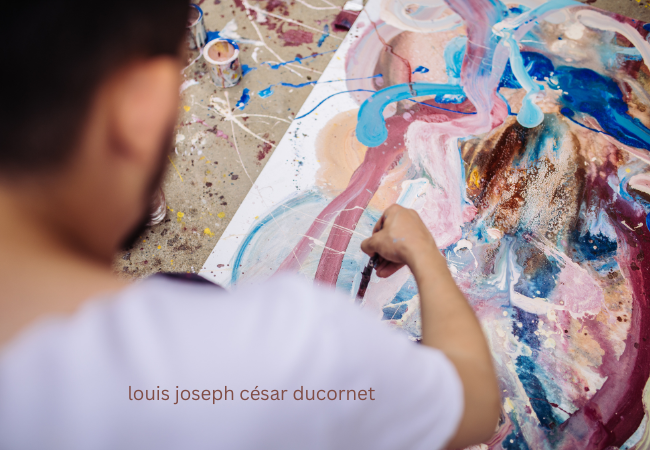Louis Joseph César Ducornet, a name that might not be familiar to many, represents a remarkable chapter in art history. Born without arms, Ducornet defied the odds to become a celebrated artist in 19th-century France. His life and work are testaments to human resilience and creativity, leaving an indelible mark on the art world.
Early Life and Background
Louis Joseph César Ducornet was born on January 10, 1806, in Lille, France. Coming from a modest family, Ducornet’s parents recognized his exceptional talent early on. Despite the physical challenges he faced, his innate artistic abilities began to shine through even in his childhood.
Overcoming Physical Challenges
Ducornet was born without arms, a condition known as bilateral amelia. Rather than letting this define his limitations, Ducornet found innovative ways to express his artistic vision. Using his feet and mouth, he mastered the art of painting, demonstrating an incredible level of skill and precision that astonished his contemporaries.
Education and Training
His early education was influenced by local artists who were captivated by his determination and talent. Ducornet received mentorship from prominent painters who helped refine his techniques. He later enrolled in the École des Beaux-Arts in Paris, where he honed his skills further and developed a distinct artistic style.
Artistic Style and Techniques
Ducornet’s work is characterized by its intricate detail and expressive quality. He employed a range of techniques, often using a brush attached to a special device he controlled with his mouth. This allowed him to create works that were both delicate and vibrant, showcasing his unique perspective and meticulous attention to detail.
Major Works and Achievements
Some of Ducornet’s most notable works include “The Martyrdom of Saint Sebastian” and “The Birth of Venus.” These pieces not only highlight his technical prowess but also his ability to convey deep emotion and narrative through his art. Ducornet received numerous awards and recognitions, solidifying his place in the art world despite his physical limitations.
Themes in Ducornet’s Art
Ducornet often explored themes related to the human condition, nature, and mythology. His works reflect a profound understanding of beauty and suffering, frequently portraying scenes of mythological and religious significance. These themes resonated deeply with viewers and critics alike, adding layers of meaning to his artistry.
Influence and Legacy
Ducornet’s impact on the art world extends beyond his lifetime. He inspired countless artists, particularly those facing physical challenges, by demonstrating that passion and talent can overcome seemingly insurmountable obstacles. His contributions to art history are studied and celebrated, influencing both his contemporaries and future generations.
Personal Life
Despite his professional achievements, Ducornet led a relatively private personal life. He formed close relationships with family and friends who supported his artistic journey. His daily routines were adapted to accommodate his unique way of working, reflecting his dedication and perseverance.
Challenges and Triumphs
Throughout his life, Ducornet faced numerous challenges, including societal perceptions and personal struggles. However, his triumphs in the art world provided a powerful counter-narrative to these challenges, illustrating his resilience and determination to succeed despite the odds.
Exhibitions and Public Recognition
Ducornet’s works were featured in several major exhibitions, gaining significant public and critical acclaim. His unique story and extraordinary talent drew large audiences, eager to witness the creations of an artist who painted without the use of his arms. These exhibitions played a crucial role in establishing his reputation and legacy.
Ducornet in Historical Context
The 19th-century art scene was rich with innovation and change, and Ducornet’s work stood out even amidst such a vibrant period. Compared to other artists of his time, Ducornet’s methods and themes were particularly distinctive, making his contributions all the more significant.
End of Life and Posthumous Recognition
Ducornet continued to create and inspire until his death on April 27, 1856. His legacy, however, did not end with his passing. Posthumously, his work has been celebrated in numerous retrospectives and exhibitions, ensuring that his contributions to art are remembered and appreciated.
Modern Appreciation
Today, Ducornet is viewed as a pioneering figure who broke barriers and redefined what is possible in the realm of art. Modern exhibitions and art historians continue to explore and celebrate his work, ensuring that new generations recognize his extraordinary achievements and the inspiration he provides.
Conclusion
Louis Joseph César Ducornet’s life and art are a testament to the boundless possibilities of human creativity and resilience. His ability to overcome significant physical challenges to create profound works of art serves as an enduring inspiration. Ducornet’s legacy is not just in the masterpieces he left behind but in the powerful message that determination and talent can transcend any obstacle.
FAQs
Who was Louis Joseph César Ducornet?
Louis Joseph César Ducornet was a 19th-century French painter known for his extraordinary ability to create art despite being born without arms.
What was unique about Ducornet’s painting style?
Ducornet’s painting style was unique due to his use of his feet and mouth to manipulate the brush, allowing him to create detailed and expressive works of art.
How did Ducornet paint without arms?
Ducornet painted using a special device that allowed him to control the brush with his mouth and feet, showcasing remarkable dexterity and precision.
What are some famous works of Ducornet?
Some of Ducornet’s famous works include “The Martyrdom of Saint Sebastian” and “The Birth of Venus,” which highlight his technical skill and emotional depth.
How is Ducornet remembered today?
Ducornet is remembered as a pioneering artist who overcame physical challenges to make significant contributions to art, inspiring future generations and continuing to be celebrated in modern exhibitions and retrospectives.




